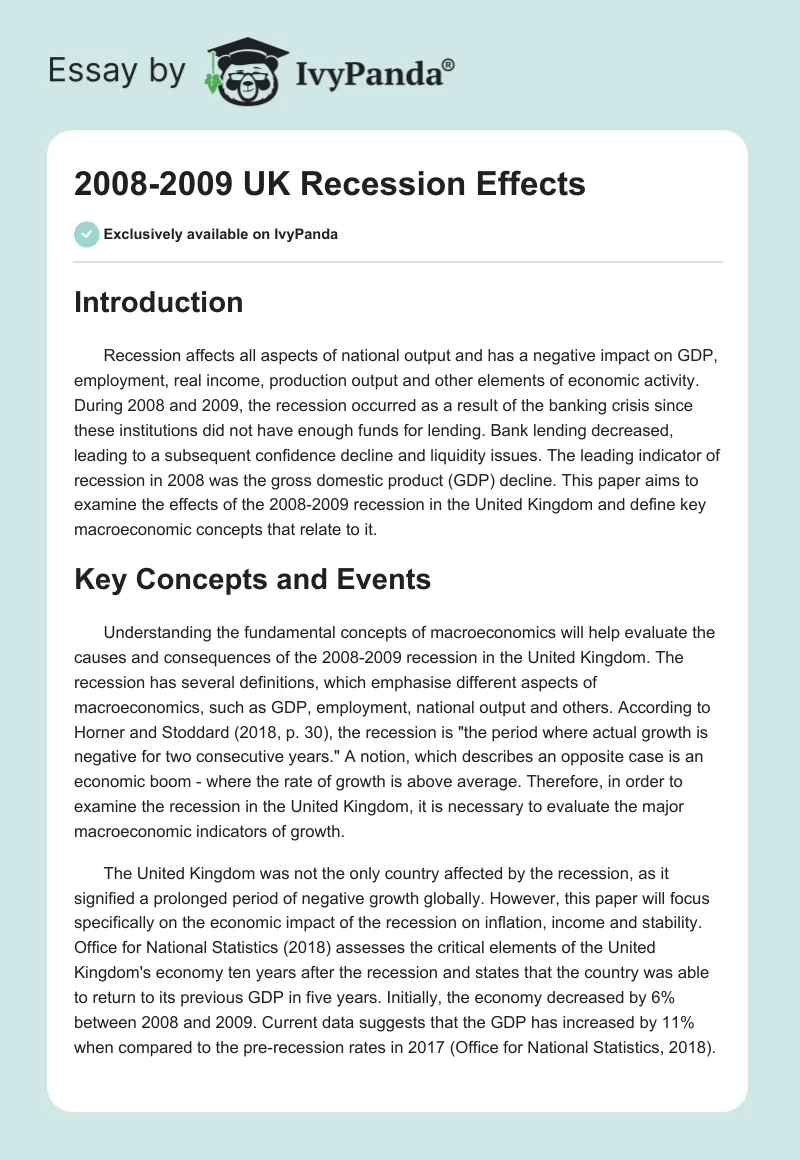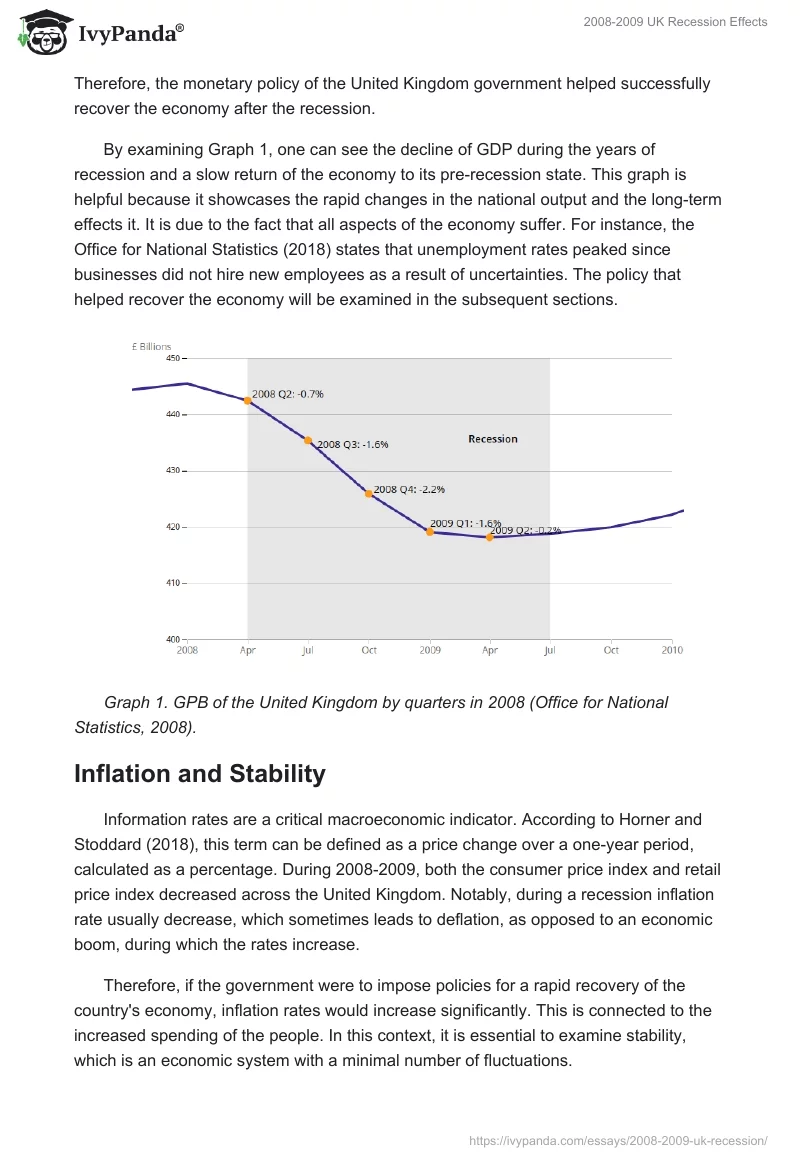Introduction
Recession affects all aspects of national output and has a negative impact on GDP, employment, real income, production output and other elements of economic activity. During 2008 and 2009, the recession occurred as a result of the banking crisis since these institutions did not have enough funds for lending. Bank lending decreased, leading to a subsequent confidence decline and liquidity issues. The leading indicator of recession in 2008 was the gross domestic product (GDP) decline. This paper aims to examine the effects of the 2008-2009 recession in the United Kingdom and define key macroeconomic concepts that relate to it.
Key Concepts and Events
Understanding the fundamental concepts of macroeconomics will help evaluate the causes and consequences of the 2008-2009 recession in the United Kingdom. The recession has several definitions, which emphasise different aspects of macroeconomics, such as GDP, employment, national output and others. According to Horner and Stoddard (2018, p. 30), the recession is “the period where actual growth is negative for two consecutive years.” A notion, which describes an opposite case is an economic boom – where the rate of growth is above average. Therefore, in order to examine the recession in the United Kingdom, it is necessary to evaluate the major macroeconomic indicators of growth.
The United Kingdom was not the only country affected by the recession, as it signified a prolonged period of negative growth globally. However, this paper will focus specifically on the economic impact of the recession on inflation, income and stability. Office for National Statistics (2018) assesses the critical elements of the United Kingdom’s economy ten years after the recession and states that the country was able to return to its previous GDP in five years. Initially, the economy decreased by 6% between 2008 and 2009. Current data suggests that the GDP has increased by 11% when compared to the pre-recession rates in 2017 (Office for National Statistics, 2018). Therefore, the monetary policy of the United Kingdom government helped successfully recover the economy after the recession.
By examining Graph 1, one can see the decline of GDP during the years of recession and a slow return of the economy to its pre-recession state. This graph is helpful because it showcases the rapid changes in the national output and the long-term effects it. It is due to the fact that all aspects of the economy suffer. For instance, the Office for National Statistics (2018) states that unemployment rates peaked since businesses did not hire new employees as a result of uncertainties. The policy that helped recover the economy will be examined in the subsequent sections.

Inflation and Stability
Information rates are a critical macroeconomic indicator. According to Horner and Stoddard (2018), this term can be defined as a price change over a one-year period, calculated as a percentage. During 2008-2009, both the consumer price index and retail price index decreased across the United Kingdom. Notably, during a recession inflation rate usually decrease, which sometimes leads to deflation, as opposed to an economic boom, during which the rates increase.
Therefore, if the government were to impose policies for a rapid recovery of the country’s economy, inflation rates would increase significantly. This is connected to the increased spending of the people. In this context, it is essential to examine stability, which is an economic system with a minimal number of fluctuations.
Inequalities of Income
It is evident that the recession also had an impact on employment rates and income of the people in the United Kingdom. Heyes, Tomlinson and Whitworth (2017) state that in the period of the crisis, unemployment reached 8%, while in 2007, it was 5.3%. Currently, the rates continue to decrease, with 5.6% unemployed in 2017. However, this crisis has revealed several issues in the labour market, such as underemployment. This concept describes people who have to work fewer hours or take jobs that do not correspond with their education and qualifications, which leads to them receiving less income.
Inequality of income is a concentration of financial resources within a small percentage of the population. This concept usually refers to the disposable income of individuals, and there are several approaches to measuring it, such as the Gini coefficient. This measure suggests that the United Kingdom has the highest coefficient of income inequality when compared to other European countries (Income inequality in the UK, 2019; Coulter, 2016).
According to the report by the United Kingdom Parliament, “following the 2008 recession, there was a small fall in income inequality as higher-income households saw a larger fall in income in real terms” (Income inequality in the UK, 2019, para. 10). The primary reason for this difference in real earnings of high-income households and those with low income is a rapid decrease in real earnings. This occurrence is substantiated by Horner and Stoddard (2018), who argue that economic growth has a danger of increasing income inequality. Therefore, recession mainly affected the income of high-earning households in the United Kingdom, reducing inequality.
Causes of Economic Growth, Business Cycles and Reasons for Recession
Economic growth and a subsequent increase in GDP and production output can be a result of an increase in business activity in a country. This leads to more output in terms of goods and services. The business cycle describes the variance of the economy over time. This concept refers to fluctuations in growth, which repeat over time (Horner and Stoddard, 2018). The primary reason for recession, which arises from the definition of this concept, is a decrease in production output which occurs over two quarters.
In the context of the 2008-2009 crisis, the leading causes were connected to a large number of high-risk mortgages, which reduced the liquidity of banks. In general, as part of the business cycle, the upward and downward changes in the GPD are natural. However, in the case of the 2008-2009 crisis, they were caused by improper policies and mortgages that could not be repaid.
Monetary Policy
In the United Kingdom, the Monetary Policy Committee (MPC) is an institution that oversees the monetary policy of the country. The main scope of activity for MPC is the interest rate for short-term borrowings, which is the definition of monetary policy (Horner and Stoddard, 2018). Deleidi and Mazzucato (2018) state that the primary strategy, which helped recover the economy, was the Quantitative Easing (QE) programme, implemented by the Bank of England (BOE). The main objective of it was to stimulate lending for banks. However, initially, the approach was not practical since the demand for borrowing was low. Next, QE aimed to lower interests rates and purchase corporate bonds.
GDP
As was noted in the previous sections, recession and economic boom are two different indicators of growth or decline of the economy, which have to measured to determine the national output. For this purpose, GDP is used, which helps determine the level of production in a country. The economy of the United Kingdom, evaluated through GDP, has been steadily growing since 1992. However, since April 2008, it began declining, which was the first consequence of the recession.
According to the Office for National Statistics (2018, para. 1), GDP is measured by “adding up the value of all the goods and services produced in the country.” In the case of the United Kingdom, the country experienced five quarters GDP decrease, and as was examined earlier, two consecutive quarters are considered a recession. Therefore, GDP is an essential indicator since it helps determine the success of the economic activity.
National Income
In general, there are three key ways to measure national income, which are -product, income and expenditure. The first one refers to the final value of goods, and the second is the calculation of factor incomes, and the final is the overall spending (Horner and Stoddard, 2018). The first method refers to all wages received during a one year period, profits of businesses and interest received by landers or landowners. When applied to the recession, this approach allows calculating the flow fluctuations in finances received by individuals in the country. The second method accounts for all products and services across different sectors of the economy and allows assessing the decrease of output upon recession.
Finally, the third method is the spending of individuals and businesses and accounts for the flow of money. Notably, prior to the recession, the national income has been increasing. The consequences of the recession allowed the United Kingdom to demonstrate the growth of national income only in 2013 (Office for National Statistics, 2018).
Recovery
Graph 1 and evidence reviewed above suggest that the policy of the United Kindom’s government, as well as measures taken by banks, helped restore the economy. In the section dedicated to the monetary policy, the strategy of MPC and BOE were described, as the two authorities aimed to improve bank lending. For this purpose, the interest rates were lowered by BOE and reached 0.5% (Deleidi and Mazzucato, 2018).
The primary purpose was to attract investors and business owners and enable the flow of money. Therefore, by lowering its rates, BOE encouraged other financial institutions in a country to do the same. This should help increase the number of mortgages and the supply of housings, as well as help businesses expand (Horner and Stoddard, 2018). However, such an approach discourages people from depositing money since they would be able to earn less.
Conclusion
Overall, this paper focused on the fundamental concepts of macroeconomics, which help understand the specifics of recession and determine its long-term consequences. Macroeconomics refers to the examination of the economy of a country, in this case, the United Kingdom, as a whole. A recession can be defined as a noticeable decline in economic activity lasting for a specified period, which is usually reflected in the country’s GDP. The monetary policy of MPC and BOE helped the country recover and reach a GDP 11% greater when compared to pre-recession rates.
Reference List
Coulter, S. (2016) ‘The UK labour market and the ‘great recession’ in Myant, M., Theodoropoulou, S. and Piasna, A. (eds.) Unemployment, internal devaluation and labour market deregulation in Europe. Brussels: European Trade Union Institute, pp. 197-227.
Deleidi, M. and Mazzucato, M. (2018) The effectiveness and impact of post-2008 UK monetary policy. Web.
Heyes, J., Tomlinson, M. and Whitworth, A. (2017) ‘Underemployment and well-being in the UK before and after the Great Recession’, Work, Employment and Society, 31(1), pp. 71–89.
Horner, D. and Stoddard, S. (2018) Need to know: Edexcel a-level economics. London: Philip Allan.
Income inequality in the UK (2019) Web.
Office for National Statistics (2018) The 2008 recession 10 years on. Web.


